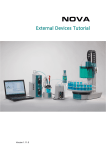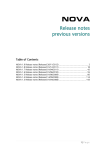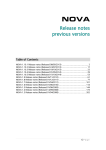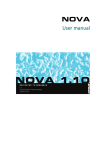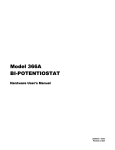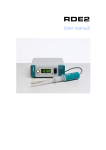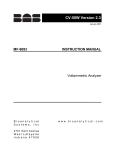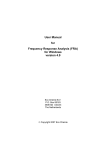Download Cyclic voltammetry tutorial
Transcript
Version 1.11.0 NOVA Cyclic voltammetry tutorial 1 – Cyclic voltammetry staircase Cyclic voltammetry is the most popular electrochemical method. It provides both qualitative and quantitative information as well as a fast and reliable characterization tool. The staircase cyclic voltammetry method is a particular format of cyclic voltammetry during which a potential step profile is applied to the electrochemical cell and the response of the cell is measured at the end of each step. This allows to measure only the faradaic current, since the capacitive current, which appears at the beginning of the step, arising from the double layer charging, has a much higher decay rate. 2 – The CV staircase command NOVA provides a CV Staircase command which can be used to perform potentiostatic staircase cyclic voltammetry measurements 1. Figure 1 shows an overview of the CV staircase command and its parameters. Figure 1 – Overview of the CV staircase command Note Like all the measurement commands, the CV staircase command is carefully timed by the Autolab instrument. Galvanostatic cyclic voltammetry measurements can be performed using the CV Staircase galvanostatic command. 1 1|Page NOVA Cyclic voltammetry tutorial The CV staircase command has the following parameters: • Start potential (V): defines the start potential, in Volts. The start potential value can be located outside of the scan range defined by the lower and upper vertices. Upper vertex potential (V): defines the upper vertex potential, in Volts. The upper vertex potential must be higher than the lower vertex potential. Lower vertex potential (V): defines the lower vertex potential, in Volts. The lower vertex potential must be lower than the upper vertex potential. Stop potential: defines the stop potential, in Volts. The stop potential value must be located within the scan range defined by the upper and lower vertices. Number of stop crossings: defines the number that the scan should cross the stop potential value in order to stop the measurement. Step potential (V): defines the length of the potential step used in the CV staircase command, in Volts. The step potential can be positive or negative. With a positive step, the scan starts from the start potential towards the upper vertex potential. With a negative step, the scan direction is reversed. Scan rate (V/s): defines the scan rate, in Volts per second 2. Signal sampler: defines the specific sampler used during the CV staircase. By default, Time, Potential applied and WE(1).Current are measured, but additional electrochemical signals can be added to the sampler. Moreover, the Scan signal, which provides the scan number, will be added to the data. Options: defines the options used during the cyclic voltammetry measurement (automatic current ranging and cutoffs). • • • • • • • • Warning Important restrictions: in order to properly identify the scans in the data, it is important to make sure that the following conditions are respected when defining the parameters of the CV staircase command: • • The Stop potential must be < than the Upper vertex potential – the potential step. The Stop potential must be > than the Lower vertex potential + the potential step. If these conditions are not respected, NOVA will try to adjust the parameters to the closest possible solution, but in this case the correct identification of the scan numbers cannot be guaranteed. The CV staircase command in NOVA provides a flexible framework for the definition of the scan parameters. In a typical cyclic voltammetry experiment, it is assumed Because of the maximum sampling rate of the ADC164 module, the scan rate (in V/s) divided by the potential step (in V) should always be lower than 12.000 s-1, with only one signal defined in the sampler. 2 2|Page NOVA Cyclic voltammetry tutorial that the start and stop potentials should be the same. With NOVA, this is not the case anymore, and the user is free to define any type a potential scan using the set of parameters available. 2.1 – Comparison with the Cyclic voltammetry staircase of GPES There are two very significant differences between the Nova Cyclic voltammetry staircase and the GPES version. 1. Nova CV staircase has four different potentials: Start, Upper vertex, Lower vertex and Stop potential. The CV in GPES does not have a Stop potential. 2. Nova CV staircase does not have a number of cycles but a number of stop crossings. These two differences allow for more flexibility when building a potential profile for cyclic voltammetry. The example shown in Figure 2 has the following parameters. Start potential: 1.2 V, upper vertex: 1 V, lower vertex: -0.5 V, stop potential: 0.8 V, number of stop crossings: 5. Figure 2 – Example of cyclic voltammetry in NOVA 3|Page NOVA Cyclic voltammetry tutorial 3 – Using the CV staircase command The standard Autolab Cyclic voltammetry potentiostatic procedure provides a good example of the CV staircase command (see Figure 3). Figure 3 – The Autolab Cyclic voltammetry potentiostatic procedure The Autolab Cyclic voltammetry procedure performs a single scan, from 0 V to an upper vertex potential of 1 V, then to a lower vertex potential of -1 V and finally stopping at a potential of 0 V. The number of stop crossings is 2. Figure 4 shows the potential profile of this experiment. 4|Page NOVA Cyclic voltammetry tutorial Figure 4 – The potential profile applied with the two stop crossings used in the Autolab cyclic voltammetry potentiostatic procedure In the Autolab cyclic voltammetry potentiostatic procedure, the stop potential is equal to the start potential. 4 – Changing the scan direction In the CV staircase command, the scan direction is defined by the sign of the step potential. If the step potential is positive, the scan direction will be from the start potential to the upper vertex potential (see Figure 4). If the step potential is negative, the scan direction will be from the start potential to the lower vertex potential. If the Autolab cyclic voltammetry potentiostatic procedure is repeated, using a step potential of -0.00244 V instead of 0.00244 V, the potential profile will be identical to the one displayed in Figure 5. 5|Page NOVA Cyclic voltammetry tutorial Figure 5 – The potential profile applied with the two stop crossings used in the Autolab cyclic voltammetry potentiostatic procedure, with a negative potential step Note It is possible to change the scan direction during a cyclic voltammogram using the button, available in the Autolab display (see Figure 6). 6|Page NOVA Cyclic voltammetry tutorial Figure 6 – Pressing the button changes the scan direction during a measurement The button can be pressed any number of times to reverse the scan direction. The measurement stops when the number of stop crossings has been reached. 5 – Changing the number of scans The number of scans in the CV staircase command is defined by the number of stop crossings. This unusual definition of the number of scans has many advantages that will be illustrated in this tutorial. Two stop crossings are required for one cycle. This means that it is possible to use an odd value as the number of stop crossings, in order to perform an extra half scan at the end of the measurement. Figure 7 shows the potential profile obtained with the Autolab cyclic voltammetry procedure, using three stop crossings instead of two. The first two stop crossings define the first cycle and the third stop crossing defines the second, half cycle. 7|Page NOVA Cyclic voltammetry tutorial Figure 7 – The potential profile applied with three stop crossings 6 – Using different start and stop potentials Unlike other implementations of the cyclic voltammetry method, it is possible, with the CV staircase command in NOVA to use a different start and stop potential. In the standard Autolab Cyclic voltammetry potentiostatic procedure, the start and stop potentials are linked and are therefore identical. If the link is removed, it is possible to define different values of the start and the stop potential. Figure 8 shows an example of a potential profile used during the CV staircase command corresponding to a start potential of 0 V, a stop potential of 0.2 V and a number of stop crossings equal to 3. 8|Page NOVA Cyclic voltammetry tutorial Figure 8 – Using different start and stop potentials in the CV staircase command The measurement starts at 0 V and stops at 0.2 V. The number of stop crossings is three. A number of stop crossings equal to 2 would have generated less than half a scan. 7 – Start potential outside of the scan range A final benefit of the CV staircase command is the possibility of defining a start potential outside of the scan range. Figure 9 shows an example of such a potential profile. In this example, the start potential is -2 V whereas the stop potential is 0 V. Again, three stop crossings are required for the first scan to be complete. Note The stop potential value must be unlinked from the start potential. Please refer to the User Manual for more information (see Section 2.4.4). 9|Page NOVA Cyclic voltammetry tutorial Figure 9 – The CV staircase command allows the start potential can be located outside of the scan range Note The stop potential value must always be located within the scan range defined by the upper and lower vertex potential. 8 – Circular buffers NOVA uses so-called circular buffers in the CV staircase command. These buffers have a defined length, but can be cycled through an infinite amount of time, unlike linear buffers. This means that when the number of scans is high, the number of data points recorded can exceed the length of the circular buffer. This means that only the last X measured data points will be saved at the end of the experiment, where X is the length of the circular buffer. NOVA will display a warning during validation when the estimated number of points exceeds the length of the circular buffer (see Figure 10). 10 | P a g e NOVA Cyclic voltammetry tutorial Figure 10 – A warning is displayed during validation when the circular buffer is exceeded Note The length of the circular buffer is optimized when the procedure is started in order to maximize the memory use on the embedded processor of the Autolab. 11 | P a g e













